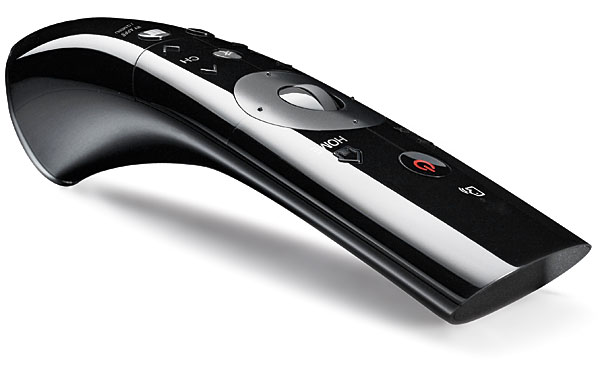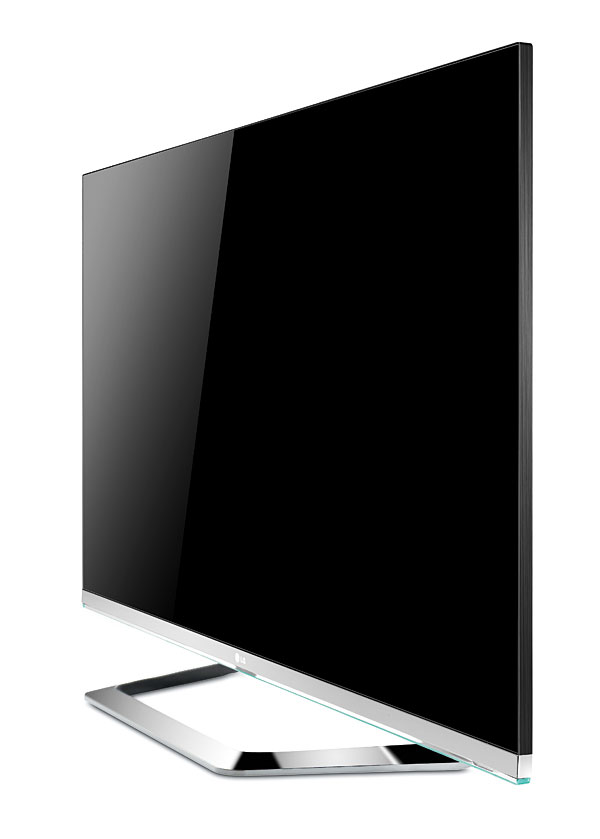LG 55LM8600 3D LCD HDTV Page 2
 Surprisingly, the LG’s Super Resolution control produced subtle but often welcome enhancements. I had to look closely at first to see, for example, how this adjustment brought out the fine crinkles in Julia Roberts’ lips and details in the actors’ skin textures. Once you see it, however, it’s unmistakable. But don’t overdo it; I kept the set’s two Sharpness controls on 5 (maximum is 50); at a setting of 10, hints of over-sharpening began to show up as “ringing” around the edges of objects. And standard-definition material benefitted little from this feature, if at all. But for good HD sources, it’s definitely worth trying, even though the set’s resolution is excellent without it.
Surprisingly, the LG’s Super Resolution control produced subtle but often welcome enhancements. I had to look closely at first to see, for example, how this adjustment brought out the fine crinkles in Julia Roberts’ lips and details in the actors’ skin textures. Once you see it, however, it’s unmistakable. But don’t overdo it; I kept the set’s two Sharpness controls on 5 (maximum is 50); at a setting of 10, hints of over-sharpening began to show up as “ringing” around the edges of objects. And standard-definition material benefitted little from this feature, if at all. But for good HD sources, it’s definitely worth trying, even though the set’s resolution is excellent without it.
Mirror Mirror also proved an excellent test for color, apart from the film’s obviously deliberate sepia tint. The LG was equally at home with the bright hues in the palace and the dingy browns in the dwarfs’ hut. Greens were natural, and the overall color saturation was rich but natural.
LCD sets have typically produced poor results when viewed from off center. But LG has long used a type of LCD panel—called IPS for In Plane Switching—that is far superior in this regard. And that superiority is obvious on the 55LM8600. You’ll still see a great picture at almost any practical seating position. Even at extreme horizontal angles, up to at least 45 degrees, the picture quality holds up. The vertical viewing angle in 2D is also wide enough to include any practical viewing position. With this LG, the fight for the money seat is over!
The primary drawback to IPS LCD panels, however, is that they tend to have inferior contrast compared to other LCD technologies. But add LED local dimming, and everything changes. And this set’s edge-lit local dimming was among the very best I’ve yet seen. The LED lighting appears to be arrayed across the top (and perhaps bottom) of the screen and lights the picture in several independent vertical zones. With LED Local Dimming set on High, you can see the LEDs turn off (or nearly so) when the source goes to black, and the black screen uniformity is good. But if you display a small, bright spot on the screen (for example, a Blu-ray player’s pause bug), not only does that spot light up, but the black areas above and below it lighten as well, though to a much lesser degree.

Similar types of halo effects aren’t uncommon in edge-lit LCDs, but the LG was better than most in this regard. And, fortunately, program material rarely has totally discrete points of light that would allow you to detect this; even a street lamp on a dark night scene throws light around it. On real material, therefore, I almost never saw this banding effect. Only bright white titles against a black background and, occasionally, the black bars on 2.35:1 films showed it, and even then it was subtle and never distracting. Overall, the LG’s black level and shadow detail earn a solid B-plus rating.
Longtime readers are likely getting tired of my referencing Harry Potter movies, but the fact remains that the later Potter adventures, in particular, are extremely useful for gauging a set’s black level and shadow detail. This set handled all of my favorite, dark test scenes in Harry Potter and the Half-Blood Prince beautifully: Harry and Dumbledore in a darkened village (chapter 2); Harry in the dark field outside the Weasley house (chapter 3); Harry returning to Hogwarts at night (chapter 7); a nighttime chase ending with the burning of the Weasley house (chapter 17); and more. There was no obvious lightening of low-contrast scenes and no gray fog obscuring dark details.
3D Performance
The screen design needed to implement the passive 3D technology (a layer called the patterned retarder) inserts visible horizontal lines into 3D images. That’s true of the 55LM8600 as well, though they’re less intrusive now than in the first passive sets. The closer you sit, the more visible the lines become. For me, at a reasonable viewing distance, their main effect is to add a slight graininess to the picture (aided perhaps by the reduced vertical resolution of a passive set). After a few minutes into a 3D movie, however, I was able to mentally tune out the lines.
The horizontal viewing angle for 3D is as good as in 2D. Vertically, however, if your eyes are too low, the 3D starts to fade, and if too high (above the top of the set), 3D crosstalk (ghosting) develops. But from any practical seating position, the 3D effect is superb and the 3D crosstalk inconsequential. The 2D-to-3D conversion mode also works reasonably well, though it does produce an odd effect on close-ups of performers’ eyes. They appear to be positioned several inches behind their eyelids!

With my 3D settings, I measured a peak brightness level of 25 foot-lamberts. This is exceptional for a 3D display and compares favorably to the 32 to 33 ft-L I used for 2D. The set can produce even more brightness than this in 2D, if desired, but 25 ft-L is pushing the maximum possible in 3D. Nevertheless, it’s enough to make 3D images pop off the screen in a way they almost never do with the dimmer 3D that most active-glasses 3D sets provide. In the subdued room lighting I always use for movie watching, the LG’s 3D images never looked dim, though if your 2D settings lean toward brighter settings than mine, or you watch 3D in bright daytime lighting, they might.
Combine that brightness with the total lack of 3D crosstalk on the sources I watched (at any practical viewing height); good resolution (not as good as in 2D, but few viewers will likely complain); light, comfortable 3D glasses; and good color, and this may well be my favorite set so far for 3D viewing. Avatar, A Christmas Carol, Tron: Legacy, and Tangled all looked good enough in 3D to almost (but not quite) make me prefer them to their 2D versions. Those who have read my past 3D reviews will know this isn’t faint praise.
Conclusions
Great black levels? Check. Solid color? Check. Superb resolution? Check. Near plasma-quality off-axis performance? Check. Compelling 3D, with glasses so light and comfortable, it’s easy to forget you have them on? Check, check, check.
The LG 55LM8600 actually exceeded the performance of the two 55LM9600 Nano samples we reviewed in our September 2012 issue and costs hundreds of dollars less. For me, its balance of strengths and lack of serious weaknesses places it at or near the top of the list of the best 3D LCD HDTVs we’ve yet tested.








































